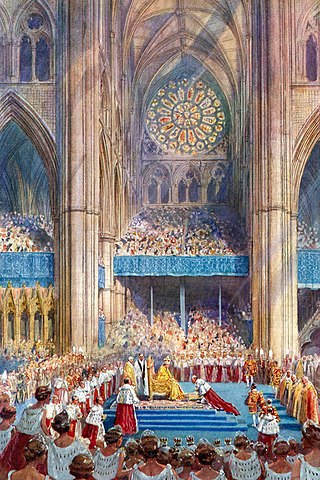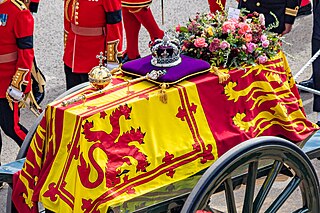
Crown jewels are the objects of metalwork and jewellery in the regalia of a current or former monarchy. They are often used for the coronation of a monarch and a few other ceremonial occasions. A monarch may often be shown wearing them in portraits, as they symbolize the power and continuity of the monarchy. Additions to them may be made, but, since medieval times, the existing items have been typically passed down unchanged, symbolizing the continuity of a monarchy.

The Crown Jewels of the United Kingdom, originally the Crown Jewels of England, are a collection of royal ceremonial objects kept in the Jewel House at the Tower of London, which include the coronation regalia and vestments worn by British monarchs.

The Honours of Scotland, informally known as the Scottish Crown Jewels, are the regalia that were worn by Scottish monarchs at their coronation. Kept in the Crown Room in Edinburgh Castle, they date from the 15th and 16th centuries, and are the oldest surviving set of crown jewels in the British Isles.

The coronation of the monarch of the United Kingdom is an initiation ceremony in which they are formally invested with regalia and crowned at Westminster Abbey. It corresponds to the coronations that formerly took place in other European monarchies, which have all abandoned coronations in favour of inauguration or enthronement ceremonies. A coronation is a symbolic formality and does not signify the official beginning of the monarch's reign; de jure and de facto his or her reign commences from the moment of the preceding monarch's death or abdication, maintaining legal continuity of the monarchy.
'I was glad' is an English text drawn from selected verses of Psalm 122. It has been used at Westminster Abbey in the coronation ceremonies of British monarchs since those of King Charles I in 1626.

The Coronation Chair, also known as St Edward's Chair or King Edward's Chair, is an ancient wooden chair that is used by British monarchs when they are invested with regalia and crowned at their coronation. The chair was commissioned in 1296 by King Edward I of England to house the Stone of Scone, the symbol of royal authority in Scotland. Since 1308, it has been used at every coronation of English and British Monarchs at Westminster Abbey. The coronation chair is arguably the most valuable and revered piece of furniture in the world. The chair was named after Edward the Confessor, and is currently kept in St George's Chapel at Westminster Abbey, London, and was last used by King Charles III at his coronation in 2023.

The Crown of Scotland is the centrepiece of the Honours of Scotland. It is the crown that was used at the coronation of the monarchs of Scotland, and it is the oldest surviving crown in the British Isles and among the oldest in Europe.

The coronation of Elizabeth II as queen of the United Kingdom and the other Commonwealth realms took place on 2 June 1953 at Westminster Abbey in London. Elizabeth acceded to the throne at the age of 25 upon the death of her father, George VI, on 6 February 1952, being proclaimed queen by her privy and executive councils shortly afterwards. The coronation was held more than one year later because of the tradition of allowing an appropriate length of time to pass after a monarch dies. It also gave the planning committees adequate time to make preparations for the ceremony. During the service, Elizabeth took an oath, was anointed with holy oil, was invested with robes and regalia, and was crowned Queen of the United Kingdom, Canada, Australia, New Zealand, South Africa, Pakistan, and Ceylon.

Coronations were previously held in the monarchies of Europe. The United Kingdom is the only monarchy in Europe that still practises coronations. Other European monarchies either have replaced coronations with simpler ceremonies to mark an accession or have never practised them. Most monarchies today only require a simple oath to be taken in the presence of the country's legislature.

The coronation of George VI and his wife, Elizabeth, as king and queen of the United Kingdom and the Dominions of the British Commonwealth, Emperor and Empress consort of India took place at Westminster Abbey, London, on Wednesday 12 May 1937. George VI ascended the throne upon the abdication of his brother, Edward VIII, on 11 December 1936, three days before his 41st birthday. Edward's coronation had been planned for 12 May and it was decided to continue with his brother and sister-in-law's coronation on the same date.

The coronation of the Danish monarch was a religious ceremony in which the accession of the Danish monarch was marked by a coronation ceremony. It was held in various forms from 1170 to 1840, mostly in Lund Cathedral in Lund, St. Mary's Cathedral in Copenhagen and in the chapel of Frederiksborg Palace in Hillerød.

Elizabeth II, Queen of the United Kingdom and the other Commonwealth realms, died on 8 September 2022 at Balmoral Castle in Scotland, at the age of 96. Elizabeth's reign of 70 years and 214 days was the longest of any British monarch. She was immediately succeeded by her eldest son, Charles III.

The coronation of Charles III and his wife, Camilla, as king and queen of the United Kingdom and the other Commonwealth realms, took place on Saturday, 6 May 2023 at Westminster Abbey. Charles acceded to the throne on 8 September 2022 upon the death of his mother, Elizabeth II. It was the first coronation held since that of Elizabeth II in 1953, nearly 70 years prior.

The Stole Royal is an item of regalia used during the coronation of a British monarch, similar to the stoles worn as vestments by clergymen. It is donned after the anointing of the monarch and is worn throughout the crowning, receiving of homage and conclusion of the communion. The Stole Royal is removed, with other garments, before the procession from Westminster Abbey for which the Imperial Robe is worn.

The Robe Royal is a robe worn by the British monarch when he or she is crowned. It is donned just before the monarch is invested with the Orb, Ring and Sceptres. It is worn during the crowning and paying of homage. The Robe Royal used is one originally created for the 1821 coronation of George IV.

The Imperial Robe is a robe used in the Coronation of the British monarch. It is donned in the final stages of the ceremony for the procession of the monarch from Westminster Abbey to the waiting Gold State Coach. These Robes were last seen at the Coronation of Charles III and Camilla, with King Charles III wearing the Imperial Robe of George V, and Queen Camilla having a new robe made for her.

The Elizabeth Sword is a ceremonial state sword kept in Edinburgh Castle. It is used on ceremonial occasions in place of the Sword of State, which is part of the Honours of Scotland, that Scottish monarchs used at their coronation. The Elizabeth Sword, along with the Crown of Scotland and the Sceptre, were presented to King Charles III in 2023. The sword, named after Queen Elizabeth II, was commissioned in 2022.















